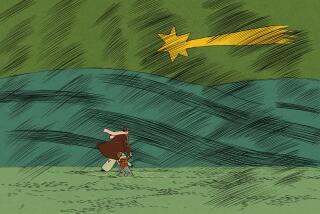Stories Enhance Meaning of Easter and Passover
You don’t have to be a zealot, or even particularly pious, to conclude that the commercialization of religious holidays has gotten out of hand. Take today for example. With a forest of chocolate bunnies, marshmallow chicks and brightly painted eggs competing for children’s attention, it’s going to be difficult to get many of them to sit still long enough to explain why today is among the most hallowed days on both the Christian and Jewish calendars. And if you can’t get them to focus on the opening of the major league baseball season, good luck teaching them about Passover and Easter!
A visit to a neighborhood bookstore turned up a wealth of materials for parents seeking a more well-rounded explanation of the holidays.
Among the best was “The Exodus: Moses’ Story From the Bible” (Tommy Nelson Inc., 95 pages; $12.99), which mixes a series of factual tidbits with insightful essays by Charles R. Swindoll to explain the events leading to the Jewish people’s passage from slavery in ancient Egypt to freedom, a biblical story commemorated during the eight-day Jewish Passover celebration, which ends Thursday. Compiled by Bruce Bickel and Stan Jantz, the book is illustrated with drawings from the animated DreamWorks film “The Prince of Egypt.”
For younger children, there’s “Uncle Eli’s Special-for-Kids, Most Fun Ever, Under-the-Table Passover Haggadah” (by Eliezer Lorne Segal, illustrations by Bonnie Gordon-Lucas, No Starch Press, 59 pages; $12.95). The irreverent tone of the book’s rhymes were inspired by the likes of Dr. Seuss, which Segal acknowledges in a foreword.
“I tried to tell the story of the Passover Seder in the style of . . . beloved children’s books,” he writes, “in verse and with help from lots of zany characters and creatures.” As a result, the holiday tradition suddenly becomes less intimidating and much more accessible to young readers. Plus the book closes with a seven-page glossary of important Passover-related terms.
Two of the better Easter primers--both aimed at grade-school readers--have been around a while, which isn’t a problem since the Easter story hasn’t changed much in 2,000 years.
“A Child’s Story of Easter” (by Etta Wilson, illustrated by Mary Ann Utt, Ideals Children’s Books, 24 pages; $6.95) is a 2-year-old book that explains Easter in terms even the youngest child can understand.
Aileen Fisher’s “The Story of Easter” (Harper Collins, 30 pages; $5.95) was first published as part of an anthology in 1968. Two years ago, Harper Collins revived the text and paired it with some original artwork by Stefano Vitale to create a colorful and accessible edition aimed at grade-school readers.
The scholarship is solid, the writing straightforward and informative, and the vocabulary remarkably simple. Fisher even manages to explain how painted eggs became an important part of Easter observances.
But no one knows where the Easter bunny came from, admits Fisher, who suggests it might have something to do with the fact that rabbits have long been a symbol of abundant life. Even so, my 2-year-old son burst into tears the first time he saw a 6-foot-tall bipedal rabbit posing for pictures in the mall.
Fortunately, the Easter bunny is a little less frightening in book form. In “There Really Is an Easter Bunny” (Simon Spotlight, 20 pages; $3.50), the gang from television’s “The Busy World of Richard Scarry” prepare for Busytown’s annual Easter egg hunt. There seems to be some doubt that the Easter bunny really exists, however, so Hilda Hippo steps forward to save the day.
The Easter bunny lurks in the background of “Max’s Chocolate Chicken” (by Rosemary Wells, Dial Books for Young Readers, 22 pages; $8.99), which is probably just as well since he’d have a hard time drawing attention away from the irrepressible Max and his long-suffering sister, Ruby. In this story for preschoolers, a distracted Max is routed by Ruby in the family Easter egg hunt but winds up taking the prized chocolate chicken anyway.
Also for preschoolers is “Corduroy’s Easter” (by B.G. Hennessy, pictures by Lisa McCue, Viking Children’s Books, 14 pages; $11.99), a colorful lift-the-flap book featuring the popular teddy bear created by Don Freeman. The flaps become especially useful during Corduroy’s Easter egg hunt at the end of the story.
More to Read
Sign up for our Book Club newsletter
Get the latest news, events and more from the Los Angeles Times Book Club, and help us get L.A. reading and talking.
You may occasionally receive promotional content from the Los Angeles Times.








